The Yemen Middle-Eastern spicy paste inspires this peppery cilantro parsley sauce recipe, and flavors include garlic, caraway, cardamom, coriander, and cumin for a simple, quick zhug sauce.
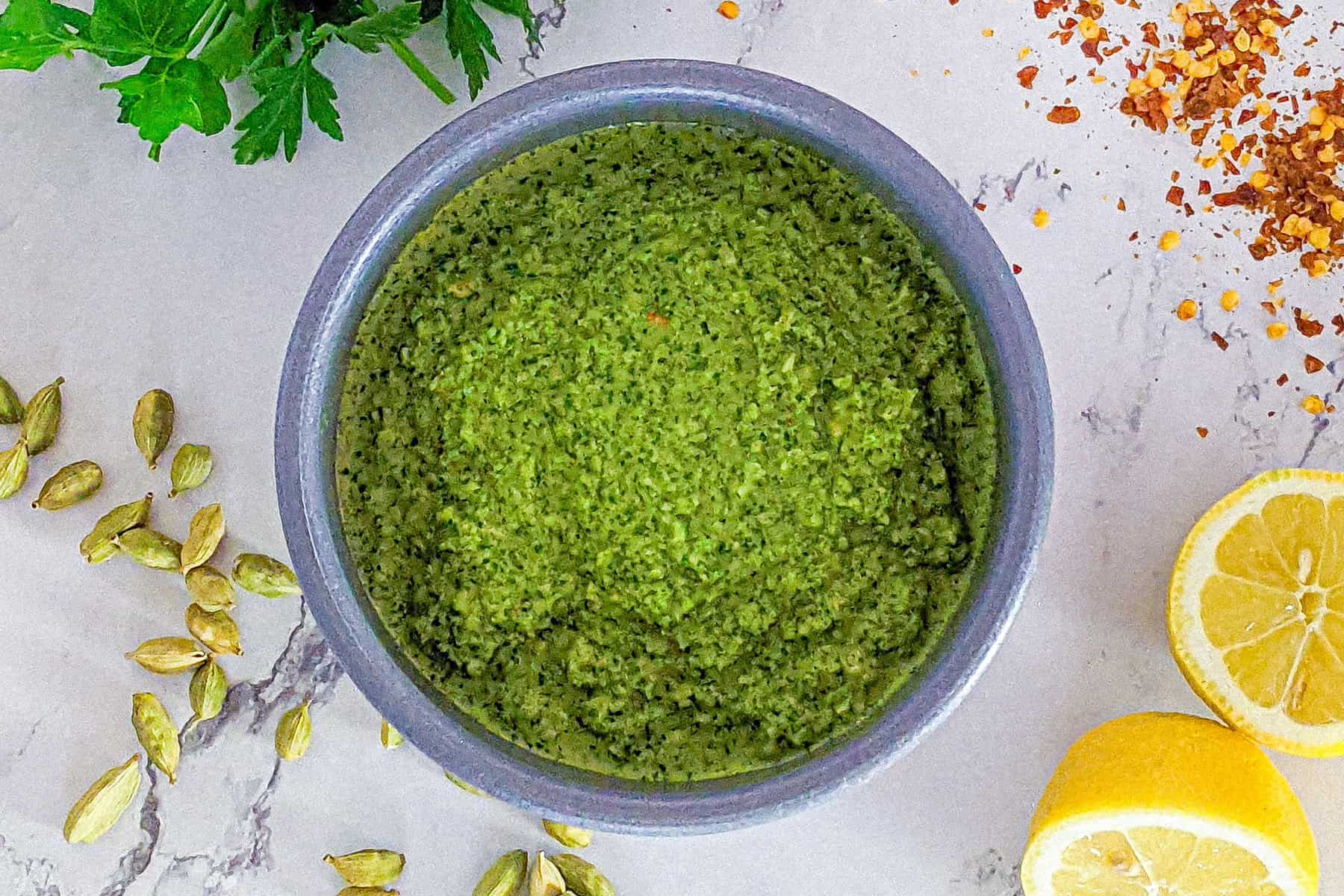
Table of Contents
Jump to:
- Your Gateway Sauce
- What is Zhug?
- What Zhug Tastes Like
- How I Use Zhug
- Is it Zhug, Zhoug, S'hug?
- Zhug vs. Harissa
- Trader Joe’s Zhug vs. Mine
- Ingredients with Steps
- Substitutions
- Equipment
- Storage
- Cooking Tips
- Frequently Asked Questions
- Sauce Recipes
- Middle Eastern Recipes
- 📖 Recipe
- Subscribe to my YouTube Channel.
- Have a Question or Comment?
Your Gateway Sauce
This quick zhug sauce is a fresh green sauce that packs a punch! The Yemenite spicy green sauce inspires it (or paste, depending on how rough you like it), blending garlic, cilantro, parsley, cumin, coriander, caraway, and cardamom with lemon juice, zest, and some serious heat from jalapenos or serranos.
Finally, extra virgin olive oil rounds it out to create a versatile condiment that’s super simple to whip up. This is your gateway sauce if you're diving into Middle Eastern cuisine!
What is Zhug?
Zhug, also known as zhoug, is a hot, spicy condiment from Yemen that looks like a chunky green paste made from a perfect blend of garlic, cilantro, chili peppers, and spices.
Zhug, or Zhough in Arabic and S’hug in Hebrew, has become increasingly popular due to its versatility and bold flavor. On the Scoville scale, zhug typically scores between 3,000 - 10,000 SHU, Scoville Heat Units. Learn more about the Scoville Scale.
The ingredients and heat level of zhug can vary slightly depending on the region where it’s prepared. Some recipes call for freshly chopped jalapeno or serrano peppers to boost spiciness, along with lemon juice for a touch of tartness.
My recipe takes it up a notch with lemon zest to enhance the aromatics. Plus, it’s super easy to make, and a little zhug goes a long way! Trust me, it’ll be the best thing in your refrigerator.

Looking for authentic Yemeni recipes? Check out Sifra and A Yemeniayah's Recipes.
What Zhug Tastes Like
Zhug is a flavor explosion, combining spicy cilantro sauce vibes with a zesty, garlicky punch. The heat from the hot peppers (jalapenos or serranos) builds on your tongue, but it’s balanced with fresh herbs and citrusy brightness from the lemon. If you love spicy food, this one’s for you—just be ready for that spicy green sauce burn that sneaks up on you!
How I Use Zhug
My favorite way to use quick zhug sauce is mixing it into yogurt to marinate chicken—trust me; it gives your grilled chicken a juicy, herby kick! I also love adding it to ground meat for the most flavorful turkey burgers or meatballs you’ve ever had.
Zhug takes that basic weeknight dinner and turns it into something exciting. Plus, it’s a Middle Eastern sauce that makes everything taste just a little more delicious.
Other Ideas for Zhug
You’ll love this recipe because it’s incredibly fresh, and the sauce itself is endlessly versatile. You can use it to marinate meats, tofu, and vegetables and add a bold, zesty kick when grilling, baking, or roasting.
Try stirring it into yogurt or sour cream for a spicy dip, or drizzle it over roasted vegetables, scrambled eggs, or grain bowls for an extra layer of flavor. My favorite way is to spoon it onto a falafel pita sandwich, but it also makes a fantastic topping for avocado toast, burgers, or even mixed into pasta for a unique twist.

The possibilities are endless!
More Recipes Ideas
Zhug is excellent as a condiment topping, sauce, and marinade. A favorite way to use it is in the Baked Zhug Chicken with Spiced Brown Rice and Steamed Broccoli.
It can also be used to make the Spicy Zhug Hummus with Feta – Twist on Classic Hummus and with that used in the Zhug Feta Hummus Chicken Wrap.
Even try it in soup, like the Green Lentil Kale Stew, or in a grilled meat dish, like the Grilled Zhug Ras El Hanout Lamb Chops and Tomato Salad recipe.
Is it Zhug, Zhoug, S'hug?
It's all of them. You’ll notice zhug is also spelled zhoug and s’hug (skhug). So what’s the deal? It depends on who is making it. For example, the Jewish community uses the word hug, pronounced Skoog.
Additionally, there was a large population of Jews in Yemen until the late 1940s to the 50s, when many Jews relocated to Isreal, about 1,300 miles away, bringing their Yemite culture and unique religious practices.
As a result, Israel is a diverse country with a mixture of Jewish and ethnic diversity, different traditions, and religious practices in one country.
Zhug vs. Harissa
Zhug and Harissa are like cousins in the Middle Eastern condiment world, but they bring very different heat. When I’m ordering a shawarma pita wrap, I choose either zhug or harissa based on my mood (and who’s making it, let’s be real).
Zhug is all about that fresh, peppery herb heat, while harissa is more smoky, earthy, and packed with roasted chilies. One’s a spicy cilantro sauce, the other’s a rich peppery paste—totally different vibes, but both a win.
Trader Joe’s Zhug vs. Mine
I remember picking up Trader Joe’s version of zhug once—hey, no shame in the store-bought game! While their zhug is great in a pinch, my homemade version packs way more unique flavor from fresh herbs and a better balance of spices.
If you’re short on time, Trader Joe’s is a good option, but if you’ve got 10 minutes and a food processor, go for the homemade zhug—totally worth it!
Ingredients with Steps
Traditionally, this Yemenite Zhug paste has green hot peppers from the region, along with garlic, lemon, cardamom, coriander, cumin, and caraway seeds.
Sometimes, when you want to try a new recipe, you can’t because half of the items you don't have. I also tried to make it a little easier with most of the ingredients you’ll have to get started. And looking at the picture below, you can see how easy it is to gather these zhug ingredients.
First, rinse the cilantro and parsley, then cut off the rough bottom stems. Then, blend it in the food processor with jalapenos, chili pepper flakes, garlic, lemons juice and zest, cumin, coriander, cardamom, salt, and olive oil. Voila!
Culinary Glossary
This section provides concise definitions of key ingredients and techniques to enhance understanding and improve cooking skills related to this recipe. Check out the live Culinary Glossary here.
- Zhug - A Middle Eastern spicy green sauce made from fresh herbs, garlic, and hot peppers.
- Cardamom - A warm spice often used in Middle Eastern and Indian cuisines.
- Caraway - An aromatic spice similar to cumin, adding a sharp, earthy flavor.
- Cumin - A deep, earthy spice commonly used in spice blends.
See the zhug recipe card for quantities.
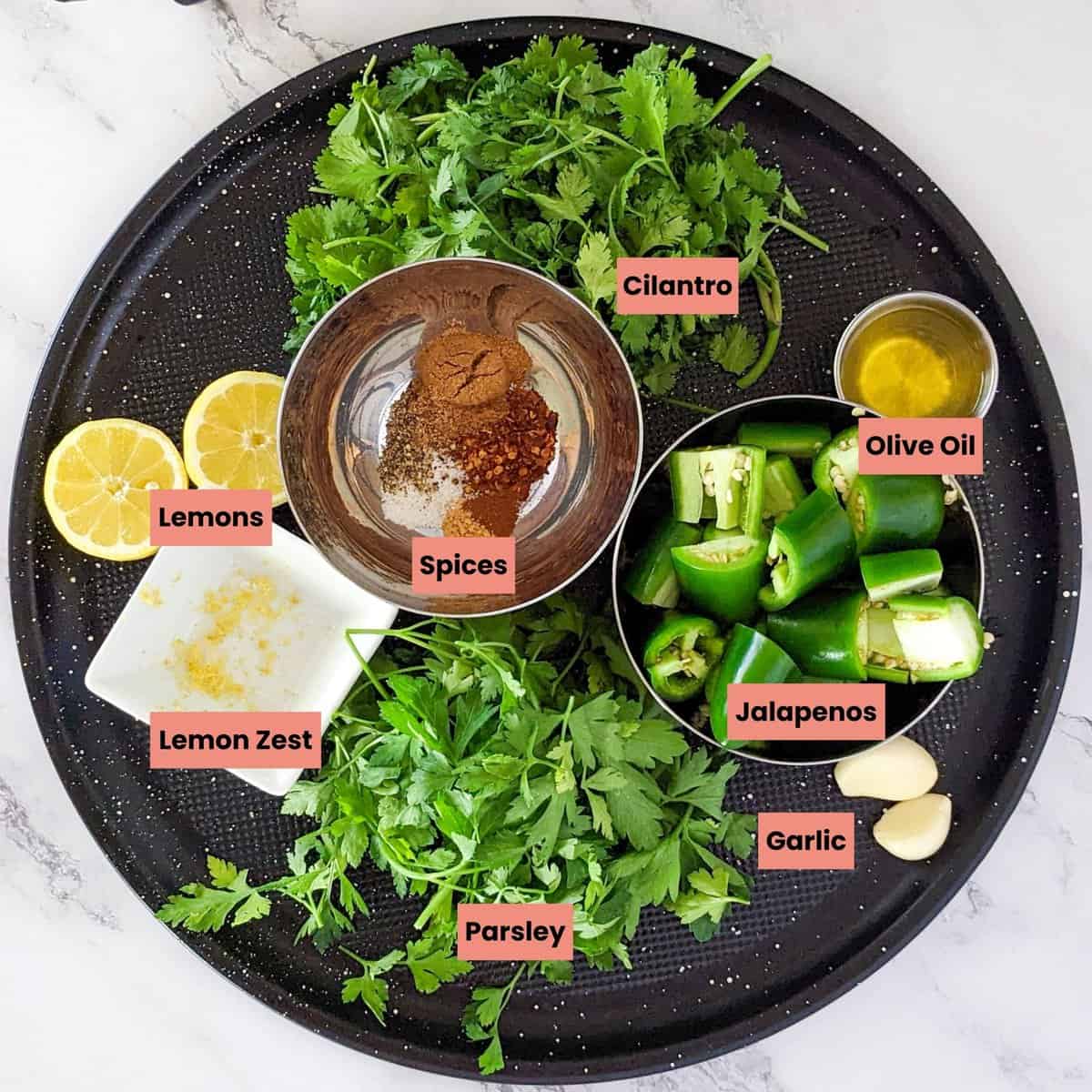
Substitutions
Dairy Free
- Yay! This recipe is dairy-free.
Gluten-Free
- Bonus! It's also gluten-free.
Vegetarian
- Triple Threat! It's vegetarian, too!
Convenience
- Jalapeno Pepper - Use Serrano or a mixture of both.
- Chili Pepper Flakes - Substitute 1 Thai chili, Bird's Eye Chili, or ⅛ teaspoon ground cayenne pepper for every ½ teaspoon.
- Ground Cardamom - Try ¼ teaspoon ground ginger instead with ¼ teaspoon ground cinnamon per ½ teaspoon to accomplish a similar flavor.
Change Heat Level - Modify the zhug recipe's heat level to your liking and learn more about the Scoville Scale and Chili Pairings.
Equipment
- Food Processor - Essential for blitzing the herbs, spices, and hot peppers into the perfect rough paste. To develop this zhug recipe, I used my small KitchenAid 3.5 Cup Food Chopper and had to do it in two batches by blending the herbs first and then adding the rest. I also suggest using a larger food processor, like a KitchenAid 7-Cup Food Processor.
- It may also work in a personal blender. Additionally, I own both of these, and I've made an herb marinade, Epis, a Haitian green seasoning with similar ingredients using my Hamilton Beach Portable Blender and Nutribullet Personal Blender. Plus, don't be fooled; both use plugs, not batteries, before getting the food chopper, and it worked fine.
- Another method would be using a motor and pestle, the old-school way my grandma used to. This method takes a bit longer, but it uses a different method that brings out more flavor by bruising the herbs and garlic and releasing the oils instead of chopping it with a blade. Also, just chopping everything with a knife won't work. You'll have to find a way to smash and blend everything.
- Zester - Used to zest the lemon to enhance the flavor of this zhug recipe to add a punch of fresh citrus. I've used a Microplane Classic Zester Grater for over two decades, plus any recipe that suggests testing, you might see me using it in my videos. It's a great tool to have. It can also grate ginger, hard cheeses, and garlic.
- Silicone Flexible Spatula: Perfect for scraping down the sides of the food processor and getting every last bit of that zhug goodness, like the GIR Non-Stick Heat Restiatn Silicone Spatula.
Kitchen Must Haves - Find other tools I use here.
Storage
- Refrigerator - Store zhug in an airtight container for up to 1 week; stir well before using. I usually keep mine in a Ball Glass Pint Regular Mouth Mason Jar.
- Freezer - Freeze zhug in ice cube trays, then transfer to a bag—defrost a cube as needed for a flavor boost.
Airtight Food Containers - I interchange glass food storage containers with plastic clipping lids or wooden push-ins. I always suggest glass storage containers because they can be microwaved, they hold food without staining, and the glass keeps the food at a more stable temperature, keeping it fresher and longer.
Try the OXO Good Grips Smart Seal Glass Rectangle Food Storage Containers or the Pyrex Freshlock Glass Food Storage Containers.
Cooking Tips
- Removing Seeds to Control Heat Level - When recipes call to remove seeds from hot peppers to control the heat level, you must remove the rib, pith, the white flesh of the pepper.
- Get More Texture - If you like your zhug with extra texture, pulse the ingredients in the food processor until you get a rough paste, leaving some bits of herbs and peppers visible.
Frequently Asked Questions
Both zhug, a green hot pepper paste from Yemen in the Middle East, and harissa, a red hot pepper paste from the Maghreb region in North Africa, are spicy, with harissa traditionally using Baklouti peppers and zhug typically made with jalapenos or serrano chilies, though the specific chili used in Yemen is unclear—if you know, drop a comment!
Zesting is peeling only the skin of the citrus fruit without the white flesh, referred to as pith. The skin contains aromatic oils and is a great addition to recipes to intensify the flavors of a dish.
A fine grater is the most convenient way to obtain the zest of the citrus fruit, usually referred to as zester or a Microplane. Learn more about Zesting on the Cook's Notebook tab.
Yes! You can reduce the amount of hot peppers or remove the seeds for a milder flavor.
Zhug is incredibly versatile—use it as a marinade, sauce, or spread on anything from grilled meats to sandwiches and grain bowls.
Stored in the fridge, it can last for up to a week, but you can freeze it for longer storage if needed!
Sauce Recipes
Looking for other sauce recipes like this? Try these:
- Green Seasoning Recipe | Epis - Haitian Style
- Creamy Lemon Greek Yogurt Dressing | Easy 5-Minute
- Habanero Tamarind Glaze | Sweet, Spicy, and Tangy
- Creole Tomato Sauce Recipe | Easy Spicy Haitian-Inspired
Middle Eastern Recipes
Looking for other Middle Eastern-inspired recipes like this? Try these:
- Beituti Chicken Shawarma Rice Bowl | Quick and Easy
- Air Fryer Chicken Shawarma | Quick with Beituti
- Quick Parsley Cucumber Tomato Feta Salad
- Marinated Sumac Onions | Easy and Quick
📖 Recipe
Quick Zhug Sauce
Ingredients
- 1 bunch cilantro
- 1 bunch parsley
- 5 medium jalapenos or serrano peppers
- ½ teaspoon crushed red pepper chili flakes
- 2 cloves of garlic
- 2 lemons juiced and zested
- 2 teaspoons ground cumin
- ¼ teaspoon ground coriander
- ½ teaspoon ground cardamom
- salt and pepper
- 2 tablespoons olive oil
Equipment
Instructions
- Save time in the kitchen: Read the instructions thoroughly, then gather and prep all your ingredients before cooking! Learn Prepping Tips.
- Prepare Ingredients: Rinse, dry and roughly chop the cilantro, parsley, and green chilies to make them easier to blend. Then, peel the garlic cloves.
- Add to Food Processor: In a food processor, add the cilantro, parsley, garlic, green chilies, cumin, coriander, cardamom, ground cloves, black pepper, and salt.
- Pulse Ingredients: Pulse the mixture a few times to break down the herbs and chilies, scraping down the sides as needed.
- Add Lemon Juice and Olive Oil: With the food processor running on low, slowly drizzle in the fresh lemon juice and olive oil. Blend until the sauce reaches a smooth but slightly textured consistency.
- Taste and Adjust: Taste the sauce and adjust seasoning if necessary. You can add more salt or lemon juice to balance the flavors.
- Serve or Store: Transfer the zhug sauce to a small jar. It can be used immediately or stored in the refrigerator for up to 1 week.
Video
Nutrition
Subscribe to my YouTube Channel.
SUBSCRIBE: 👈To my YouTube Channel to Get Notifications of New Videos.
Have a Question or Comment?
If you have a question or comment about this zhug recipe, please post it below. You will definitely get a quick response. It also helps our other readers to stay informed. Thanks!

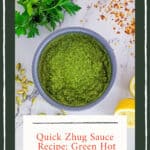
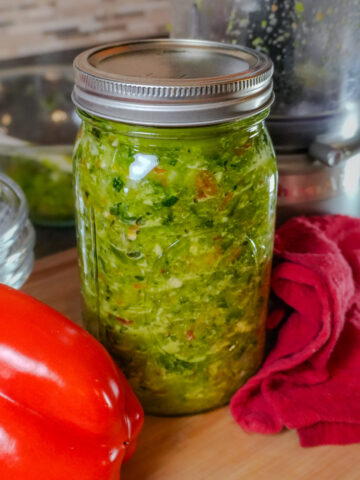
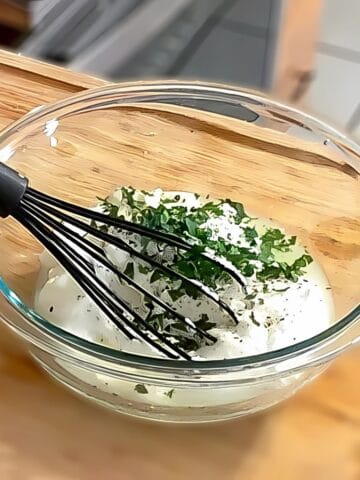

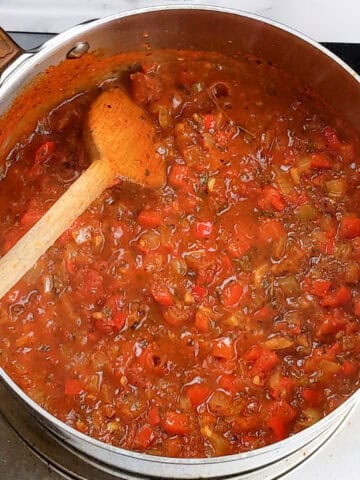


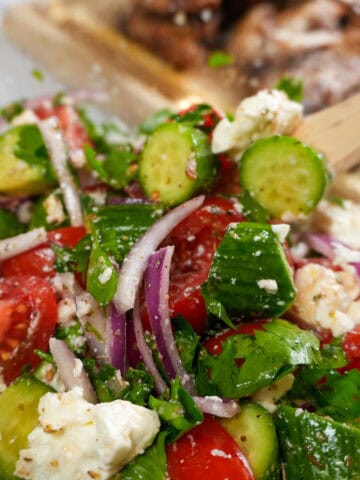
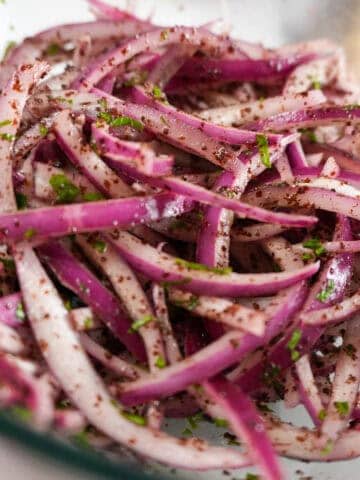
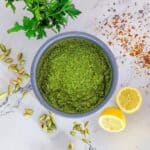
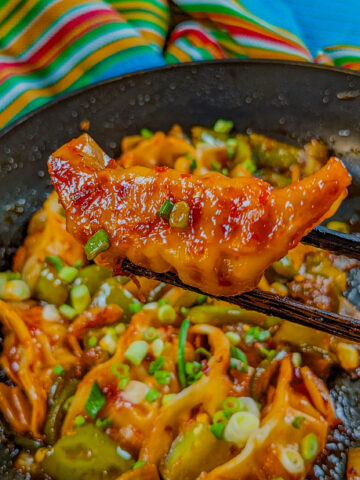
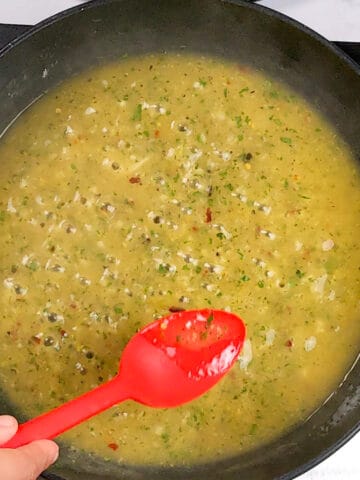
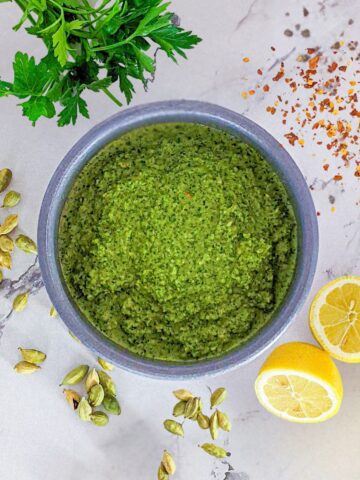
Maxine says
How can this be stored? Is it possible to can this? Can it be pasturized?
Maika says
Canning zhug sauce is generally not recommended because of the fresh herbs and raw ingredients, which can lead significant changes in texture and flavor. Pasteurization, involving heating the sauce to kill pathogens, can also change its fresh and vibrant flavors. For these reasons, preparing fresh batches is highly recommended or freezing the sauce if it is going to be used as a marinade is usually preferred for maintaining quality and safety. I've seen companies trying to do this, but doesn't seem people are "going for it", since it becomes something else. I hope this makes sense.